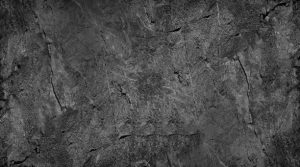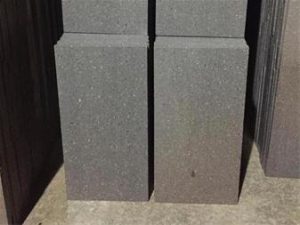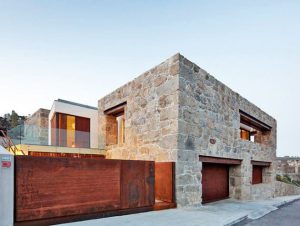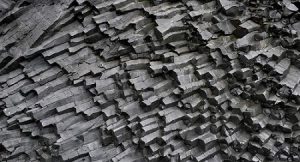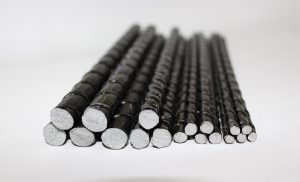Types of basalt stone coloring
The coloring of basalt stone may be diverse and depends on the mining area and different geographical conditions. Basalt is a volcanic rock and usually has dark to medium colors. These colors usually include black, dark gray, medium gray, dark brown, and even dark red. But it can be seen in some areas with more diverse changes. Below are some of the types of basalt colors that may be seen:
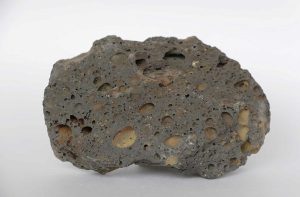
• Black: Black basalt is one of the most common colors and is usually dark black to dark black with no other colors.
• Dark gray: This type of basalt has a dark gray to black color.
• Medium gray: Basalt color usually changes to medium gray as well.
• Dark brown: In some cases, basalt can have a dark brown color.
• Dark red: In some regions of the world, basalt may have a dark red or dark red-brown color.
The variety of basalt colors is caused by the combination of minerals in it and different volcanic conditions in different regions. This stone is usually used for construction, stone artefacts, bridges, paths and various uses and has high beauty and physical resistance.
What color is compatible with basalt in the interior and exterior decoration of the building?
The choice of colors for the interior and exterior decoration of the building is applied to various factors, including the general environment, architectural style, lighting, and personal taste. However, if basalt is used in the interior and exterior decoration of the building, a number of color combinations that are compatible with it can be considered as follows:
• White: With basalt color, white can be used as a harmonious color. The combination of basalt and white often gives the environment a clean and bright feeling.
• Grey: The combination of basalt with gray creates a modern and industrial fit. This combination can be effective in modern designs and industrial architecture. Stay with us to learn more about gray basalt stone.
• Dark blue: basalt with dark blue color may also harmonize and create a stylish and innovative combination.
• Dark Brown: If your basalt has a dark brown color, mixing it with similar dark brown colors can also be attractive.
• Yellow or orange: Combination with yellow or orange colors as warm colors can add charm and life to the environment.
It is important to be careful with the combination of colors and designs according to your taste and the overall view of the project. Also, the lighting and selection of other artifacts such as the floor, furniture and windows will also have an effect on the harmony of basalt color in the decoration.
Uses of basalt stone in industry and construction
As a volcanic stone, basalt stone is used in industry and construction for various purposes due to its beautiful properties, resistance, and how strong it is. Below are some of the main uses of basalt stone in industry and construction:
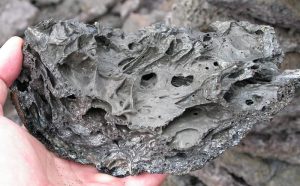
• Construction: Basalt is used as a building stone in building construction. It is used as artificial stone, underground uses (such as building floors), bridge floors, paths, and external and internal walls of buildings.
• Flooring: Basalt is used as a resistant flooring stone in high-traffic environments such as shopping centers, airports, and train stations. This stone is usually produced in different formats and densities for various floorings.
• Bridges: Basalt is used as construction artifacts in the construction of bridges and tunnels. Due to its resistance to pressure and corrosion, this stone is suitable for building reliable structures.
• Antique uses: Basalt as a natural stone with beautiful and unique designs and patterns is also used in interior and exterior decoration. This stone is very suitable for creating an antique and classic look.
• Decorative and artistic: Basalt as cut or perforated artifacts can be used in artistic and architectural decorations to create works of art or suitable landscapes.
• Stairs and walkways: Basalt is commonly used for stairs, walkways, and walkways as an artifact resistant to foot traffic.
• Cobblestone: Basalt is used as a cobblestone in public roads and public spaces. Due to its strength and durability, this stone is suitable for asphalt and road carpets.
In general, this stone is used in all kinds of construction and industrial uses due to its resistance and natural beauty.
Advantages of basalt stone in industry and construction
Basalt stone is very popular in industry and construction because of its positive characteristics. The advantages of basalt stone in this field are:
• Physical resistance: Basalt has high physical resistance against pressure and wear. These properties make basalt very suitable for use in high-traffic areas, such as public roads and airports.
• Corrosion resistance: Basalt is resistant to chemical and atmospheric corrosion. This feature makes it a cost-effective option for projects exposed to unstable weather and harsh conditions.
• Natural beauty: Basalt stone has a beautiful design and unique patterns that give it a natural look and charm. This stone is used as an ornamental element in the interior and exterior decoration of very attractive buildings.
• Heat resistance: Basalt has high heat resistance and can be used as flooring surfaces exposed to high heat (such as next to a gas stove or furnace).
• Uniform structure: Basalt has a uniform structure without large cracks, which makes it resistant to long-term construction use.
• Easy access: Basalt is available as a natural stone in many parts of the world and can usually be obtained at a reasonable cost.
• Compatibility with the environment: Basalt as a natural stone can be recycled and has a lower environmental impact than artificial stone artifacts.
The difference between basalt granite and other types
Granite and basalt are two types of mineral stones popular in the construction and decoration industry. These two types of stones are different from each other in some features and uses. Below are the main differences between granite and basalt compared to other types:
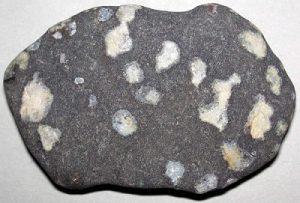
• Mineral composition: granite is composed of various mineral compounds such as feldspar, quartz and mica. These mineral compounds make granite have various colors and patterns. In contrast, basalt is composed of mineral compounds such as pyroxene, olivine, and feldspar and is usually dark to medium in color (usually black or gray).
• Physical resistance: both granite and basalt have high physical resistance against pressure and wear. However, granite is generally more resistant to corrosion.
• Common uses: Granite is used as a building stone, flooring, sink and countertop suitable for the interior and exterior of buildings. Basalt is also suitable for flooring, tiles, stone artefacts in streets and passages, and building bridges.
• Appearance and design: Granite usually has a variety of patterns and colors that have beautiful designs. As a dark to medium colored stone, basalt is usually used in applications that require a simple, modern look.
• Cost: Granite is usually a more expensive option than basalt. The cost and distribution of basalt will be lower in areas where there are basalt mines due to easier access to this stone.
Both granite and basalt have their advantages for various uses in industry and construction. The choice between them depends on the needs and design of the project. To buy basalt stone, enter Iran Plateau website.

